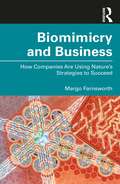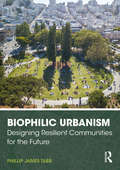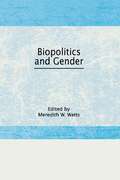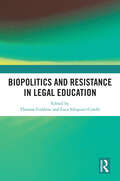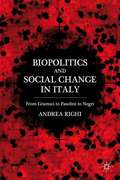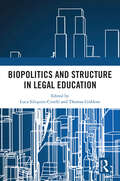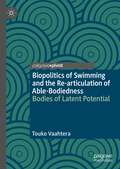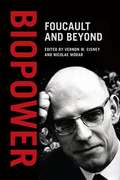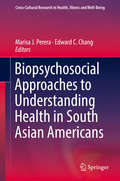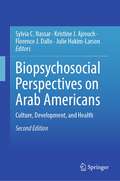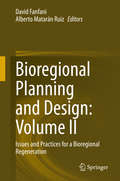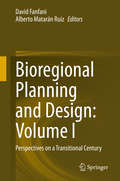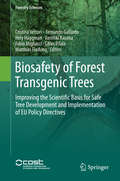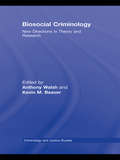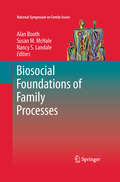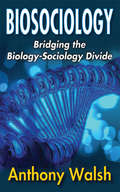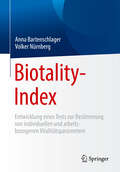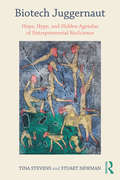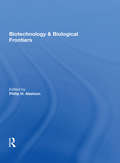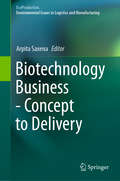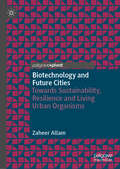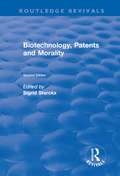- Table View
- List View
Biomimicry and Business: How Companies Are Using Nature's Strategies to Succeed
by Margo FarnsworthBiomimicry, the practice of observing then mimicking nature’s strategies to solve business challenges, offers a path to healthy profit while working in partnership, and even reciprocity, with the natural world. Other books have described biomimicry, its uses, and its benefits. This book shows readers how to create their own biomimetic or bioinspired solutions with clear benefits to the bottom line, the environment, and people. Fashioned through storytelling, this book blends snapshots of five successful companies – Nike, Interface, Inc., PAX Scientific, Sharklet Technologies, and Encycle – which decided to partner with nature by deploying biomimicry. The book details how they discovered the practices, introduced them to staff, engaged in the process, and measured outcomes. The book concludes with challenges for readers to determine their own next steps in business and offers practical and useful resources to get there. By revealing the stories of each professional’s journey with lessons they learned, then providing resources and issuing a challenge and pathway to do business better, this book serves as a tool for entrepreneurs, seasoned professionals, and students to emulate nature’s brilliance, apply it at work, and contribute to a healthier, more prosperous world.
Biophilic Cities for an Urban Century: Why nature is essential for the success of cities
by Timothy Beatley Robert McDonaldThis book argues that, paradoxically, at their moment of triumph and fastest growth, cities need nature more than ever. Only if our urban world is full of biophilic cities will the coming urban century truly succeed. Cities are quintessentially human, the perfect forum for interaction, and we are entering what could justly be called the urban century, the fastest period of urban growth in human history. Yet a growing body of scientific literature shows that the constant interaction, the hyper-connectedness, of cities leads to an urban psychological penalty. Nature in cities can be solution to this dilemma, allowing us to have all the benefits of our urban, connected world yet also have that urban home be a place where humanity can thrive. This book presents best practices and case studies from biophilic design, showing how cities around the world are beginning to incorporate nature into their urban fabric. It will be a valuable resource for scholars and professionals working in the area of sustainable cities.
Biophilic Urbanism: Designing Resilient Communities for the Future
by Phillip James TabbBiophilic Urbanism provides readers with the tools to create more nature-based urban environments that are climate positive, sustainable, and healthy. The principles of biophilia are intended to support appreciation and direct engagement with nature, to responsibly utilize on-site natural resources, and to plan according to climatic conditions and local ecological processes. It seeks to create resilient and equitable human places capable of providing critical life-support functions and a strong sense of community, and to foster experiences that raise the human spirit creating a sense of awe. Twenty-five pattern attributes are defined and explored, each of which contributes to these goals. Because of the dire necessity to respond to the COVID-19 pandemic, Biophilic Urbanism includes discussion of our need for connections, both to nature and one another, and the physical characteristics of cities and buildings relative to the contagious qualities of the air-borne virus. Case studies, found throughout the world, are presented illustrating detailed biophilic planning and design strategies. The book will be of use to practitioners and students in the fields of natural and social sciences, behavioral science and psychology, environmental engineering, health and wellness professionals, architecture, landscape architecture, interior architecture, and planning.
Biopolitics and Gender
by Meredith W Watts JrHere is an important book for social scientists interested in the influence of gender on certain types of behavior. Several perspectives are presented on the general topic of biopolitics and gender, including the points of view of brain science, endocrinology, ethology, psychophysiology, and such conventional interests as political attitudes, socialization, participation, social structure, and political hierarchy. The varied and provocative ideas explored in this volume will broaden discussions of gender beyond an exclusive focus on sex links to oppression and discrimination.
Biopolitics and Resistance in Legal Education
by Thomas Giddens and Luca Siliquini-CinelliTaking up the study of legal education in distinctly biopolitical terms, this book provides a critical and political analysis of resistance in the law school. Legal education concerns the complex pathways by which an individual becomes a lawyer, making the journey from lay-person to expert, from student to practitioner. To pose the idea of a biopolitics of legal education is not only to recognise the tensions surrounding this journey but also to recognise that legal education is a key site in which the subject engages, and is engaged by, a particular structure—and here the particular structure of the law school. This book explores the resistance to that structure, including: different ways in which law’s pedagogic structures might be incomplete, or are being fought against; the use of less conventional elements of cultural discourse to resist the abstraction of the lawyer in students’ subject formation; the centralisation of queer and feminist discourses to disrupt the hierarchies of the legal curriculum; the use of digital technologies; the place of embodiment in legal education settings; and the impacts of posthuman knowledges and contexts on legal learning. Assembling original, field-defining essays by both leading international scholars and emerging researchers, this book constitutes an indispensable resource in legal education research and scholarship that will appeal to legal academics everywhere.
Biopolitics and Social Change in Italy
by Andrea RighiThe study of how life can be controlled, supported, and manipulated has become the most urgent scientific and political task of our society. By placing the social dimension of labor at the base of the discourse of life, this book engages with the work of key intellectual figures including Gramsci, Pasolini, the neo-feminist militants of Lotta Femminista, Negri, and Virno, and reconstructs a critical genealogy of the notion of biopolitics from the point of view of twentieth and twenty-first century Italy. "
Biopolitics and Structure in Legal Education
by Luca Siliquini-Cinelli and Thomas GiddensTaking up the study of legal education in distinctly biopolitical terms, this book provides a critical and political analysis of structure in the law school. Legal education concerns the complex pathways by which an individual becomes a lawyer, making the journey from lay-person to expert, from student to practitioner. To pose the idea of a biopolitics of legal education is not only to recognise the tensions surrounding this journey, but also to recognise that legal education is a key site in which the subject engages, and is engaged by, a particular structure—and here the particular structure of the law school. This book explores that structure by addressing the characteristics of the biopolitical orders engaged in legal education, including: understanding the lawyer as a commodity, unpicking the force relations in legal education, examining the ways codes of conduct in higher education impact academic freedom, as well as putting the distinctly Western structures of legal learning within a wider context. Assembling original, field-defining essays by both leading international scholars and emerging researchers, it constitutes an indispensable resource in legal education research and scholarship that will appeal to legal academics everywhere.
Biopolitics of Swimming and the Re-articulation of Able-Bodiedness: Bodies of Latent Potential
by Touko VaahteraIn this book, Touko Vaahtera explores how “bodies of latent potential,” a cultural attachment to the idea of body as potentiality, carries with it hierarchizing hopes about better bodies. Vaahtera combines disability studies, cultural studies, feminist science studies, transgender studies, post-colonial studies, and Foucauldian genealogy to offer a provocative approach that interrogates capacities and capabilities as obvious frameworks for thinking about the body. Vaahtera explores how swimming skills emerged as a specific biopolitical question in Finland, a country that has been described as the “Land of a Thousand Lakes.” Through a profound cultural analysis focusing both on Finnish cultural texts on swimming as well as manifold more globalized texts, Vaahtera considers how the legacy of eugenics and colonialism, the hopes of civilization, and homogenizing assumptions about bodies frame how we think about human capacity.
Biopolitics: An Advanced Introduction (Biopolitics #5)
by Thomas LemkeThe first systematic overview of the notion of biopolitics and its relevance in contemporary theoretical debateThe biological features of human beings are now measured, observed, and understood in ways never before thought possible, defining norms, establishing standards, and determining average values of human life. While the notion of “biopolitics” has been linked to everything from rational decision-making and the democratic organization of social life to eugenics and racism, Thomas Lemke offers the very first systematic overview of the history of the notion of biopolitics, exploring its relevance in contemporary theoretical debates and providing a much needed primer on the topic. Lemke explains that life has become an independent, objective and measurable factor as well as a collective reality that can be separated from concrete living beings and the singularity of individual experience. He shows how our understanding of the processes of life, the organizing of populations and the need to “govern” individuals and collectives lead to practices of correction, exclusion, normalization, and disciplining. In this lucidly written book, Lemke outlines the stakes and the debates surrounding biopolitics, providing a systematic overview of the history of the notion and making clear its relevance for sociological and contemporary theoretical debates.
Biopower
by Vernon W. Cisney Nicolae MorarMichel Foucault's notion of "biopower" has been a highly fertile concept in recent theory, influencing thinkers worldwide across a variety of disciplines and concerns. In The History of Sexuality: An Introduction, Foucault famously employed the term to describe "a power bent on generating forces, making them grow, and ordering them, rather than one dedicated to impeding them, making them submit, or destroying them." With this volume, Vernon W. Cisney and Nicolae Morar bring together leading contemporary scholars to explore the many theoretical possibilities that the concept of biopower has enabled while at the same time pinpointing their most important shared resonances. Situating biopower as a radical alternative to traditional conceptions of power--what Foucault called "sovereign power"--the contributors examine a host of matters centered on life, the body, and the subject as a living citizen. Altogether, they pay testament to the lasting relevance of biopower in some of our most important contemporary debates on issues ranging from health care rights to immigration laws, HIV prevention discourse, genomics medicine, and many other topics.
Biopsychosocial Approaches to Understanding Health in South Asian Americans (Cross-Cultural Research in Health, Illness and Well-Being)
by Marisa J. Perera Edward C. ChangThis volume is the first comprehensive and interdisciplinary text to holistically improve understanding of the health of South Asians residing in the United States by considering biological, psychological, and sociocultural factors of health. The vast literatures of diverse fields – psychology, medicine, public health, social work, and health policy – are integrated by leading scholars, scientists, and practitioners in these areas to explore the impact of South Asian cultural factors on health, health risk, and illness. Chapters incorporate available theoretical and empirical information on the status of chronic health conditions in South Asians in the United States, with consideration of future directions to improve understanding of the health of this group. Cultural and ethnic insights imperative for clinical/community/medical practitioners to provide effective and culturally-appropriate care and treatment from an interdisciplinary lens are provided.
Biopsychosocial Perspectives on Arab Americans: Culture, Development, and Health
by Kristine J. Ajrouch Julie Hakim-Larson Sylvia C. Nassar Florence J. DalloThe biopsychosocial study of Arab Americans yields compelling insights into innovative theoretical and applied initiatives. In the context of a growing population of Arab Americans, coupled with the current tenure of xenophobia and exposed structural racism in the US, clinical and community practitioners must be attuned to their clients of Arab ancestry, whose experiences, development, and health concerns are distinctly different than that of their White counterparts. This second edition, with its uniquely interwoven sections of culture, psychosocial development, and health and disease, provides a rich overview of timely, critical topics. The audience for the text includes counselors, social workers, psychologists, nurses, psychiatrists, sociologists, and any other public and mental health practitioners, researchers, and policy makers who work with and on behalf of clients and patients of Arab descent. The authors represent a team of leading experts spanning disciplines of sociology, clinical mental health, and community public health. "This edition draws on leading experts in Arab American health and sociology who document the complexity of this population's immigration and acculturation experience. It offers critical and current research that speaks to the centrality of context and diversity in treating Americans of Arab descent. Contributors explore the complex and limited racial framework within which Arabs in the U.S. form their identities, and the impact of structural racism on their lives and health. This collection offers practitioners much needed insights on a population often hidden or rendered invisible by data limitations, and yet misrepresented by cultural stereotypes." Helen Hatab Samhan, Former Executive Director, Arab American Institute/Foundation. "Nassar, Ajrouch, Hakim-Larson, and Dallo’s breakthrough work in the area of culturally competent health care has been inspiring across interdisciplinary fields and to the communities they serve. Their work on Arab American health issues, in particular, has greatly improved clinical practice at the community and national levels. I heartily recommend taking the time to become familiar with their important body of work and this latest text."Ismael Ahmed, Former Michigan State Director of Health and Human Services.
Bioregional Planning and Design: Issues and Practices for a Bioregional Regeneration
by David Fanfani Alberto Matarán RuizThis book provides insights and discusses the practical application of the theoretical concept of urban bioregion complementing the general bio-regional planning cross-disciplinary issues provided in Volume I. It examines planning practices, such as relocalisation of energy flows, land protection for climate change, territorial heritage enhancement, the consideration of urban ecosystems and agro-ecology. It presents discussions on regional contexts, practices and projects for a bioregional recovery, and includes case studies from France, Belgium, Spain, Greece, Austria and Italy, discussing topics that range from the reframing of local energy production/delivery planning systems to soil protection and farmland sustainable exploitation schemes. This volume concludes with three cross-European case studies that make clear the worldwide relevance and potential of bioregional approach beyond the Global North or Western countries.
Bioregional Planning and Design: Perspectives on a Transitional Century
by David Fanfani Alberto Matarán RuizThis book provides a review of the bioregionalist theory in the field of spatial planning and design as a suitable approach to cope with the growing concerns about the negative effects of metropolization processes and the need for a sustainable transition. The book starts out with a section on rethinking places for community life, and discusses the reframing of regional governance and development as well as social justice in spatial planning. It introduces the concept of the urban bioregion, a pivotal concept that underpins balanced polycentric spatial patterns and supports self-reliant and fair local development. The second part of the book focuses on planning, and particularly on the issues that arise from the ‘circular’ recovery of the relation between city and agro-ecosystems for integrated planning and resilience of settlements and discusses topics such as foodshed planning, biophilic urbanism and the integration of rural development and spatial planning. This volume sets out the reference framework for Volume II which deals with more specific and operational issues related to spatial policies and settlement design.
Biosafety of Forest Transgenic Trees: Improving the Scientific Basis for Safe Tree Development and Implementation of EU Policy Directives (Forestry Sciences #82)
by Cristina Vettori Fernando Gallardo Hely Häggman Vassiliki Kazana Fabio Migliacci Gilles Pilate Matthias FladungThis book provides up-to-date information on the environmental impact of transgenic trees on genetically modified tree (GMT) communication strategy. It is useful to public/private organisations as well as to private and public research bodies and universities worldwide since it reports on the global status of GMT research and policy. A high number of genetically modified trees (GMTs) with altered or novel characteristics have been produced in the last 15 years. However, their very low public acceptance is a basic problem in their commercialization. Breeders anticipate economic and ecological benefits, like reduced product costs and less pressure on native forests, while opponents fear risks, such as unintended spread of GMTs. But what is true? To answer this question, the COST Action FP0905 focused on key aspects related to GMTs: (a) biological characterization; (b) assessment of possible environmental impacts; (c) socio-economic implications and public acceptance/concerns; (d) providing science-based information to communicate with the public.
Biosocial Criminology: New Directions in Theory and Research (Criminology and Justice Studies)
by Anthony Walsh Kevin M. BeaverIdeal for use, either as a second text in a standard criminology course, or for a discrete course on biosocial perspectives, this book of original chapters breaks new and important ground for ways today's criminologists need to think more broadly about the crime problem.
Biosocial Foundations of Family Processes (National Symposium on Family Issues)
by Alan Booth Susan M. Mchale Nancy S LandaleBiosocial Research Contributions to Family Processes and Problems, based on the 17th annual National Symposium on Family Issues, examines biosocial models and processes in the context of the family. Research on both biological and social/environmental influences on behavior, health, and development is represented, including behavioral endocrinology, behavior genetics, neuroscience, evolutionary psychology, sociology, demography, anthropology, economics, and psychology. The authors consider physiological and social environmental influences on parenting and early childhood development, followed by adolescent adjustment, and family formation. Also, factors that influence how families adapt to social inequalities are examined.
Biosociology: Bridging the Biology-Sociology Divide
by Anthony WalshAnthony Walsh bridges the divide separating sociology from biology—a divide created in the late nineteenth century when sociology emerged from the fields of social theory and philosophy. Walsh focuses on the viewpoint held by former American Sociological Association president Douglas Massey: sociologists have allowed the fact that we are social beings to obscure the biological foundations upon which our behaviour ultimately rests.Walsh argues that sociology has nothing to fear and a wealth of riches to gain if it pays attention to the theories, concepts, and methodologies of the biological sciences. Both study the same phenomena. Beginning with an examination of the reasons why we need a biosocial approach, Walsh explores sociology's traditional "taboo" concepts (reductionism, essentialism, etc.) and how those concepts are viewed in the natural sciences.Throughout the work, the author introduces relevant concepts from genetics and the neurosciences, using examples that will appeal to all sociologists. Later chapters apply his introductory arguments to traditional substantive sociological issues such as culture, crime, gender, socialization, social class, and the family. This book will be essential to all sociologists, evolutionary biologists, and scholars interested in the history of this important divide between the fields and where it currently stands.
Biotality-Index: Entwicklung eines Tests zur Bestimmung von individuellen und arbeitsbezogenen Vitalitätsparametern
by Volker Nürnberg Anna BartenschlagerGerade in der Zeit des demographischen Wandels und des späteren Renteneintrittsalters gilt es, Mitarbeiter möglichst lange fit und leistungsstark zu erhalten. Um jedoch zielführende Maßnahmen einzuleiten, bedarf es eines reflektierten Einsatzes von unternehmensspezifischen Bedingungen und Maßnahmen, die die individuellen Besonderheiten berücksichtigen. Ein Test über den Vitalitätszustand von Mitarbeitern kann hierfür sinnvoll sein, indem er als diagnostisches Verfahren Messgrößen zur Orientierung des IST-Zustandes liefert. Durch einen erneuten Einsatz des Biotality-Index nach einer bestimmten Zeit kann die Wirksamkeit eingeführter Maßnahmen bewertet werden. Der Biotality-Index möchte daher sowohl auf privater als auch beruflicher Ebene sensibilisieren, den Alterungsprozess über den Lebensstil positiv zu beeinflussen.
Biotech Juggernaut: Hope, Hype, and Hidden Agendas of Entrepreneurial BioScience
by Tina Stevens Stuart NewmanBiotech Juggernaut: Hope, Hype, and Hidden Agendas of Entrepreneurial BioScience relates the intensifying effort of bioentrepreneurs to apply genetic engineering technologies to the human species and to extend the commercial reach of synthetic biology or "extreme genetic engineering." In 1980, legal developments concerning patenting laws transformed scientific researchers into bioentrepreneurs. Often motivated to create profit-driven biotech start-up companies or to serve on their advisory boards, university researchers now commonly operate under serious conflicts of interest. These conflicts stand in the way of giving full consideration to the social and ethical consequences of the technologies they seek to develop. Too often, bioentrepreneurs have worked to obscure how these technologies could alter human evolution and to hide the social costs of keeping on this path. Tracing the rise and cultural politics of biotechnology from a critical perspective, Biotech Juggernaut aims to correct the informational imbalance between producers of biotechnologies on the one hand, and the intended consumers of these technologies and general society, on the other. It explains how the converging vectors of economic, political, social, and cultural elements driving biotechnology’s swift advance constitutes a juggernaut. It concludes with a reflection on whether it is possible for an informed public to halt what appears to be a runaway force.
Biotechnologies and Reproductive Agency: An Ethnography of Solo Motherhood in Spain and the United Kingdom (Routledge Research in Gender and Society)
by Ana Bravo-MorenoAs artificial reproductive technologies become available to populations that have previously not had access to them, this book asks how reproduction is being transformed by technologies and individuals whose sexual and reproductive lives may defy sociocultural norms, religious codes and national laws. Seeking to develop a novel approach for studying the families of the 21st century, it examines the uptake of assisted reproductive technologies by women who opt for lone motherhood, exploring the circulation of reproductive technologies, bodily material, and ideas in two countries recognised as leaders in ART and sexual and reproductive health rights. Through ethnographic research in Spain and the UK, it considers the localisation of assisted reproductive technologies and the ways in which the socio-cultural, politico-legal and ideological intersections between non-normative families and ARTs shape the experiences of those who take them up. A multi-sited ethnography that explores the implementation, use and experience of assisted reproductive technologies, this volume will appeal to scholars of sociology, anthropology, gender studies and science and technology studies.
Biotechnology And Biological Frontiers
by Philip H AbelsonSplit into two sections, Part I of this volume from Science is devoted to a broad sampling of the status of a revolution in applied biology. The emphasis of Part II in this volume is fundamental research rather than techniques or practical applications.
Biotechnology Business - Concept to Delivery (EcoProduction)
by Arpita SaxenaThis book is an effort to foster the entrepreneurial spirit in young minds. It reviews a wide range of product ideas, opportunities and challenges associated with start-ups. In addition, it discusses popular molecular targets for biotechnology research / the biotech industry such as attenuated microbes, gene sequences, biomarkers, and the latest advance in the sector, CRISPR. These molecular targets can be modified for the production of sufficient quantities of food and fuel. Very often, researchers limit their focus to the proof of concept, and fail to successfully convert it into a finished product. To help young entrepreneurs avoid this pitfall, the book addresses various aspects like intellectual property regulations, commerce and management. The book’s contributing authors hail from various specialized sectors, and from around the globe. Taken together, the respective chapters are intended to overcome the borders between disciplines that otherwise rarely interact.
Biotechnology and Future Cities: Towards Sustainability, Resilience and Living Urban Organisms
by Zaheer AllamThis book explores how biotechnology can lead to the reimagination of cities. In a time where the increasing adoption of technology by cities is leading to unsustainable environmental and economic concerns, biotechnology has enabled new ways of envisioning data and energy storage. Zaheer Allam thus revisits the popular concept of Smart Cities -and its associated Internet of Things (IoT) to explore how the biological sciences, coupled with technology, can be applied to cities; and in doing so, create living urban organisms on an unprecedented scale. This new concept will open up exciting avenues to providing novel solutions for climate change mitigation. The book goes on to address various potential concerns and discusses what regulatory frameworks would be needed to safely implement such a concept. It will be a useful tool for planners, policy makers and engineers as well as for researchers with in interest in the future of our cities.
Biotechnology, Patents and Morality (Routledge Revivals)
by Sigrid SterckxThis title was first published in 2000. This work documents an international and interdisciplinary workshop on the ethical aspects of the patenting of biotechnological inventions, including genes, plants and animals. The public perception is discussed, along with how these perceptions relate to ethical, social and cultural factors. The legal framework in Europe is laid out by several experts in the field of patent law and the situation in the US is also briefly described. This edition also includes a general discussion of three important theories called upon to justify the patent system: the natural rights argument; the distributive justice argument; and the utilitarian argument. The chapter about the European Directive on the legal protection of biotechnological inventions has been updated. A selection of provisions from the August 1997 draft as well as the final text of the Directive, as adopted on 12 May, 1998, are discussed and commented upon. The patent provisions of the TRIP's Agreement (the Agreement on Trade Related aspects of Intellectual Property rights, concluded in 1994 as an Annex to the Agreement Establishing the World Trade Organization) are also discussed and criticized, paying particular attention to the implications for biotechnology patents. Finally, the question is asked whether the developing countries stand to gain anything from TRIPs. A look at the results of empirical research, conducted by commentators on the economics of patenting, reveals that the new patent regime may prove to entail significant costs for the developing countries. This second edition also contains material on the EU Directive on biotechnology patents adopted in May 1998, justificatory theories of the patent system and the TRIP's agreement on Trade Related aspects of Intellectual Property rights, concluded in the GATT (WTO) framework.
